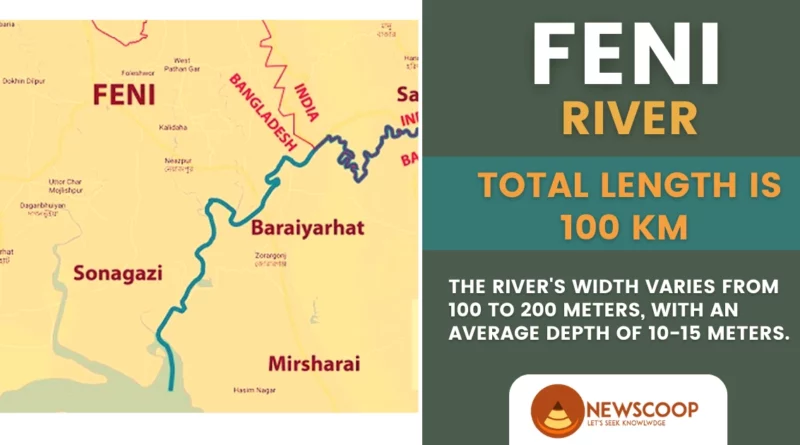Feni River System: Tributaries | Map & Location | Feni Bridge UPSC
Bangladesh, known for its abundant natural water resources, is a country of deltaic plains with over 700 rivers and tributaries. Among these water bodies, the Feni River is one of the significant ones. The river is about 100 km long and flows through the southeastern part of Bangladesh, originating in the Indian state of Tripura, flowing through Sabroom in India, and eventually emptying into the Bay of Bengal near the Chittagong port.
Geographical Location and Characteristics
The Feni River originates from the hills of Tripura, India, and flows through the southern part of Tripura state before entering Bangladesh. It then flows through the districts of Khagrachhari and Chittagong before finally merging into the Bay of Bengal. The river is around 100 km long and is the only natural boundary between Bangladesh and India.
The river’s width varies from 100 to 200 meters, with an average depth of 10-15 meters. The river’s flow is typically slow, with a current velocity of around 1.5 m/s during the monsoon season and around 0.2 m/s in the dry season.
Overview of Feni Bridge
The Feni Bridge is a significant infrastructure project in Bangladesh, connecting the Chittagong district with the southern region of the country. Some of the important points about the Feni Bridge include:
- Location: The Feni Bridge is located over the Feni River, connecting the districts of Chittagong and Cox’s Bazar in Bangladesh.
- Length: The total length of the Feni Bridge is 1.42 kilometers (0.88 miles), making it one of the longest bridges in Bangladesh.
- Construction: The construction of the Feni Bridge started in 2013, and it was completed in 2020, with a cost of around 3.6 billion Bangladeshi taka.
- Purpose: The Feni Bridge serves as a vital transportation link between the Chittagong district and the southern region of Bangladesh. It has significantly reduced travel time and distance between these regions.
- Design: The Feni Bridge is a cable-stayed bridge with two pylons and 80 cables. It has a four-lane road, two sidewalks, and a central median for safety.
- Importance: The Feni Bridge is essential for the economic development of the region, as it connects the Chittagong port, one of the busiest ports in Bangladesh, with the Cox’s Bazar tourist district. It has also improved access to healthcare, education, and other services for the local communities.
- Challenges: The construction of the Feni Bridge faced several challenges, including land acquisition, environmental concerns, and technical issues. However, these challenges were addressed through proper planning, stakeholder consultation, and project management.
Tributaries of Feni River
The Feni River is a major river in Bangladesh, and it has several tributaries that flow into it. Some of the significant tributaries of the Feni River include:
1. Halda River
The Halda River is one of the largest tributaries of the Feni River. It originates from the Lushai hills in India and flows through the Chittagong Hill Tracts before joining the Feni River in the Bay of Bengal. The Halda River is known for its breeding of several species of carps, including the famous Hilsa fish.
2. Matamuhuri River
The Matamuhuri River is another significant tributary of the Feni River. It originates in the Rangamati hill district in Bangladesh and flows through the Chittagong Hill Tracts before joining the Feni River. The Matamuhuri River is an important source of water for irrigation and is known for its scenic beauty.
3. Sangu River
The Sangu River is a transboundary river that flows through India and Bangladesh. It originates in the Arakan hills of Myanmar and flows through the Chittagong Hill Tracts before joining the Feni River. The Sangu River is known for its clear water and scenic beauty.
4. Chingri River
The Chingri River is a small tributary of the Feni River. It originates in the Mirsharai hills of Bangladesh and flows through the Chittagong district before joining the Feni River.
Significance of Feni River
The Feni River is not just a water body for the local communities, but it has significant economic, environmental, and cultural importance for the region.
1. Economic Importance
The Feni River is a vital source of water for irrigation, fisheries, and transportation in the region. The river serves as the primary source of irrigation for paddy fields, tea gardens, and vegetable cultivation, which are significant sources of livelihood for the local population.
The river is also home to various fish species, including catfish, snakehead, and carp. Fishing is a significant economic activity in the region, and the river supports thousands of fishermen and their families. The river also plays a vital role in transportation, as it provides a cheaper and more accessible mode of transport for goods and people, particularly in remote areas.
2. Environmental Significance
The Feni River plays a crucial role in maintaining the ecological balance of the region. The river’s flow helps recharge the groundwater table, which is essential for agriculture, drinking water supply, and other domestic needs. The river also provides a habitat for a diverse range of flora and fauna, including various aquatic animals, birds, and reptiles.
3. Cultural Significance
The Feni River has significant cultural and historical importance for the region. The river has been mentioned in various folk songs, literature, and poetry of the region.
The river has played a crucial role in shaping the cultural and social identity of the local communities living along its banks. The river is also an essential part of various religious and cultural festivals celebrated in the region.
Threats to Feni River
Despite its ecological, economic, and cultural significance, the Feni River is facing various threats that could affect its health and sustainability. Some of the significant threats to the river include:
- Industrial Pollution: The region surrounding the Feni River has various industries, including tanneries, textile mills, and chemical factories. These industries discharge their effluent and waste into the river, leading to water pollution. The pollution not only affects the water quality but also impacts the aquatic life and other species dependent on the river.
- Deforestation: The region surrounding the Feni River has undergone significant deforestation, leading to soil erosion, sedimentation, and loss of biodiversity. The soil erosion and sedimentation have impacted the river’s flow, leading to flooding and other water-related disasters.
- Climate Change: Climate change has led to changes in rainfall patterns and weather conditions, leading to a decrease in the river’s water flow. The decrease in the river’s water flow has impacted the irrigation, fisheries, and transportation activities dependent on the river.
- Illegal Sand Mining: Illegal sand mining is another significant threat to the Feni River. Sand mining leads to the river’s bed’s erosion and alters the river’s flow, leading to flooding and other water-related disasters. Sand mining also impacts the river’s ecology, leading to the loss of aquatic species and another biodiversity.
Steps Taken to Protect Feni River
The government of Bangladesh has taken several measures to protect the Feni River and ensure its sustainability. Some of the significant steps taken include:
- Enforcement of Environmental Laws: The government has enforced environmental laws to control industrial pollution and other activities that could harm the river’s ecology. The government has also set up monitoring systems to check the water quality and take necessary actions to prevent pollution.
- Afforestation and Reforestation: The government has initiated afforestation and reforestation programs to increase the forest cover in the region. The programs aim to reduce soil erosion, improve water quality, and protect the river’s ecology.
- Awareness Campaigns: The government has launched various awareness campaigns to educate the local communities on the river’s significance and the need to protect it. The campaigns aim to change people’s behavior towards the river and create a sense of ownership among them.
- Sand Mining Regulation: The government has regulated sand mining activities to control illegal sand mining and ensure sustainable sand mining practices. The regulation aims to protect the river’s ecology and prevent erosion and other water-related disasters.
Conclusion
The Feni River is a vital water body of Bangladesh, and its sustainability is crucial for the region’s economic, environmental, and cultural well-being. The river faces various threats, including industrial pollution, deforestation, climate change, and illegal sand mining. The government and other stakeholders have taken several steps to protect the river and ensure its sustainability.
The efforts aim to promote sustainable development practices that balance economic growth with environmental protection and cultural preservation. It is essential to continue these efforts to protect the Feni River and other water bodies in Bangladesh for future generations.
Related Links:

